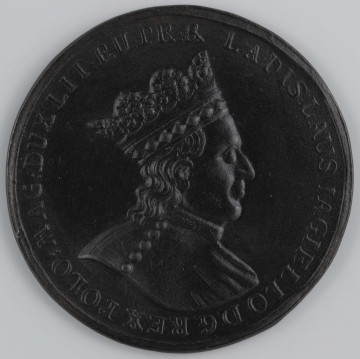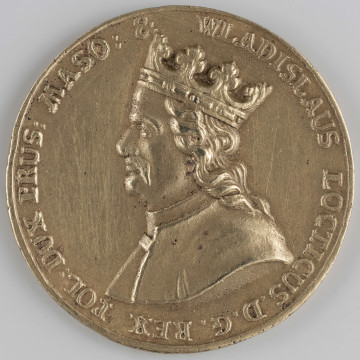
Władysław Jagiełło - Kajetan Sołtyk's entourage
1790 — 1795
National Museum in Lublin
Part of the collection: Money on Polish territory in the Middle Ages
One of the most important political achievements of Casimir the Great was joining the Halich Ruthenia to Poland in 1340. The inclusion of large territories inhabited by Ruthenians within the borders of the Polish state necessitated the introduction of a separate coinage. This role was played by silver Ruthenian quarters, also called ‘półgrosz’, and copper denars, known as pula. Both types of coins, apart from their basic role as means of payment, were also supposed to emphasise the connection of Halich Ruthenia with Poland. For this reason, both coins bore the monogram of the king in the form of the Gothic letter ‘K’, while the quarters bore the inscription: MONETA DO[MIN]I RVSCIE K[AZIMIRI] REGIS POLONIE (coin of Sir Casimir of Ruthenia, King of Poland). After the death of Casimir the Great, his nephew Louis the Hungarian assumed power in Poland. Initially, the administration of Poland and Ruthenia was taken over by Louis' mother, Elisabeth Łokietkówna. In 1372, the king entrusted Ruthenia to Prince Władysław Opolczyk. Six years later, Louis the Hungarian took independent rule over Ruthenia.
During the times of Władysław Opolczyk and Ludwik Węgierski, the minting of both quarters and Ruthenian denars continued. They also retained the existing design of the reverse. Like in the times of Casimir the Great, the reverse depicted a crown on the denarius, while on the quarto it showed a Russian lion walking to the left. However, the propaganda message of the obverse changed. The crowned letter ‘K’ was initially replaced by the initials of Władysław's name (‘W’), and later by the crowned ‘L’ of Louis the Hungarian. The change was expressed even more distinctly by the inscription on the rim. Initially on the obverse were the words: WLADISLAVS DVX (Władysław the Prince), while on the reverse: MONETA RVSSIE (coin of Rus), and from 1378 on the obverse: LODVICI R[EGIS] VNGARIE, on the reverse: MONETA RVSSIE (Louis the King of Hungary coin of Ruthenia). There were no references suggesting the connection of Halich Ruthenia with Poland. It was related to the policy of Louis of Hungary, who treated Ruthenia as a province of Hungary.
Both the quarters and the Ruthenian pula of Louis the Hungarian were minted in the mint in Lviv. Their production – like in the times of Casimir the Great – was not very large, which makes them relatively rare coins nowadays.
Leszek Poniewozik
Author / creator
Dimensions
cały obiekt:
Object type
numismatic
Technique
stamp minting
Material
silver
Creation time / dating
Creation / finding place
Owner
The National Museum in Lublin
Identification number
Location / status

1790 — 1795
National Museum in Lublin

1790 — 1810
National Museum in Lublin

1792 — 1797
National Museum in Lublin
DISCOVER this TOPIC
Museum of King Jan III's Palace at Wilanów
DISCOVER this PATH
Educational path